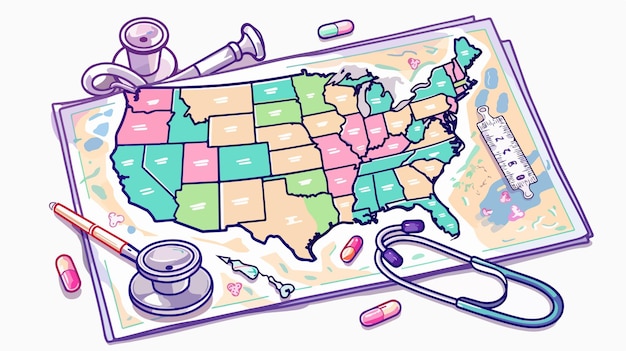Medicaid Expansion 2025: New States and Requirements You Need to Know

Medicaid expansion in 2025 may introduce new states to the program, impacting eligibility requirements and access to healthcare for millions of Americans, particularly low-income individuals and families.
The landscape of healthcare access in the United States is continuously evolving, and Medicaid expansion in 2025 could bring significant changes. This article delves into potential new states joining the expansion, crucial eligibility updates, and the broader impact on individuals and families seeking government assistance for healthcare.
Medicaid Expansion: Understanding the Basics
Medicaid expansion, a key component of the Affordable Care Act (ACA), aims to provide healthcare coverage to a larger population, particularly low-income adults. Understanding the fundamental principles of Medicaid expansion is crucial for grasping the potential impact of new states joining in 2025.
The Affordable Care Act and Medicaid Expansion
The ACA incentivized states to expand their Medicaid programs to cover adults with incomes up to 138% of the federal poverty level. This expansion significantly broadened access to healthcare for millions of Americans who previously lacked insurance options.
Benefits of Medicaid Expansion
Medicaid expansion offers numerous benefits, including increased access to primary and preventive care, improved health outcomes, and reduced financial strain on hospitals and healthcare systems. Studies have consistently shown that expansion leads to a healthier and more financially secure population.

Despite the proven benefits, some states have resisted Medicaid expansion due to concerns about costs and federal funding uncertainties.
- Improved access to healthcare services.
- Better health outcomes for low-income individuals.
- Reduced uncompensated care costs for hospitals.
- Economic benefits for states through federal funding.
These factors underscore the complex interplay of policy, economics, and healthcare access that shapes the ongoing debate about Medicaid expansion.
In conclusion, Medicaid expansion serves as a critical mechanism for increasing healthcare access and improving health outcomes, although its adoption varies across states due to differing priorities and concerns.
Potential New States Expanding Medicaid in 2025
As we look ahead to 2025, several states are considering or actively pursuing Medicaid expansion. Identifying these potential new entrants can provide insights into the future of healthcare access in the US.
States Considering Expansion
Several states that have previously resisted expansion are now reevaluating their positions due to changing political landscapes, economic incentives, and growing public support. These states include those where ballot initiatives or legislative efforts are underway to push for expansion.
Factors Influencing Expansion Decisions
The decision to expand Medicaid is influenced by a complex mix of factors, including state budget considerations, political dynamics, and the potential impact on the healthcare system. Understanding these factors is essential for predicting which states are most likely to expand in the near future.

Changes in state leadership and public opinion can also play a significant role in shifting the political calculus surrounding Medicaid expansion.
- Political shifts within state governments.
- Growing public support for healthcare access.
- Economic incentives offered by the federal government.
- Advocacy efforts by healthcare organizations and community groups.
These developments suggest that the map of Medicaid expansion may look significantly different in the coming years.
In summary, the potential expansion of Medicaid in new states by 2025 hinges on a combination of political, economic, and social factors, with public support and state leadership playing pivotal roles.
Key Eligibility Requirements for Medicaid in 2025
Eligibility requirements for Medicaid vary by state, but the general guidelines are set by the federal government. Understanding these requirements is crucial for individuals and families seeking to access Medicaid benefits.
Income Thresholds and Household Size
Income is a primary factor in determining Medicaid eligibility. Most states use income thresholds based on the federal poverty level, with specific guidelines for different household sizes. Changes to these thresholds in 2025 could affect who qualifies for coverage.
Residency and Citizenship Requirements
To be eligible for Medicaid, individuals must be residents of the state in which they are applying and must be US citizens or legal immigrants. These requirements ensure that Medicaid benefits are targeted to those who have a genuine connection to the state and country.
Age and disability status can also affect eligibility for certain Medicaid programs.
- Income verification through pay stubs or tax returns.
- Proof of residency, such as utility bills or lease agreements.
- Documentation of US citizenship or legal immigration status.
- Information about household members and their income.
Impact of Medicaid Expansion on Eligibility
Medicaid expansion typically broadens eligibility to include adults with incomes up to 138% of the federal poverty level, regardless of their family status. This expansion has significantly increased the number of people who qualify for Medicaid, particularly among low-income adults who previously lacked access to affordable healthcare.
In brief, understanding the specific eligibility requirements for Medicaid in each state is essential for individuals and families seeking to access healthcare coverage, with income, residency, and citizenship being key factors.
How to Apply for Medicaid: A Step-by-Step Guide
Applying for Medicaid can seem daunting, but it is a manageable process when broken down into clear steps. This guide provides a step-by-step overview of how to apply for Medicaid and access its benefits.
Gathering Necessary Documents
Before starting the application process, it is essential to gather all required documents, including proof of income, residency, and citizenship. Having these documents readily available will streamline the application process and reduce potential delays.
Completing the Application Form
The application form for Medicaid can typically be found on the state Medicaid agency’s website or at local social services offices. It is important to complete the form accurately and thoroughly to avoid any processing issues.
After submitting the application, it may take several weeks to receive a determination of eligibility.
- Online through the state Medicaid agency’s website.
- In person at a local social services office.
- By mail, by downloading the application and mailing it to the appropriate address.
- Assistance programs designed to ease the process for you.
Navigating the Application Process
Seeking assistance from local community organizations or healthcare navigators can be invaluable when navigating the complexities of the Medicaid application process. These resources can provide guidance, answer questions, and help ensure that the application is completed correctly.
To summarize, applying for Medicaid involves gathering necessary documents, completing the application form, submitting it through the appropriate channel, and seeking assistance from available resources to navigate the process effectively.
The Impact of Medicaid Expansion on Healthcare Access
Medicaid expansion has significant implications for healthcare access, particularly for low-income populations, healthcare providers, and the overall healthcare system. Understanding these impacts is crucial for evaluating the benefits and challenges of expansion.
Increased Coverage Rates
One of the most direct impacts of Medicaid expansion is an increase in healthcare coverage rates. By extending eligibility to more people, expansion reduces the number of uninsured individuals and families, leading to greater access to necessary medical care.
Improved Health Outcomes
Studies have consistently shown that Medicaid expansion leads to improved health outcomes for low-income individuals. Greater access to primary and preventive care allows for early detection and management of health conditions, reducing the need for costly emergency room visits and hospitalizations.
The economic benefits of Medicaid expansion also extend to healthcare providers and state economies.
- Reduced uncompensated care costs for hospitals and clinics.
- Increased revenue for healthcare providers serving Medicaid patients.
- Economic growth through federal funding and increased healthcare spending.
- Healthier communities and a more productive workforce.
Challenges and Considerations
Despite the numerous benefits, Medicaid expansion also presents some challenges, including concerns about the financial sustainability of the program and the potential for increased demand on healthcare resources. Addressing these challenges is essential for ensuring the long-term success of expansion.
In conclusion, Medicaid expansion significantly impacts healthcare access by increasing coverage rates, improving health outcomes, benefiting healthcare providers, and posing challenges related to sustainability and resources.
The Future of Medicaid: Trends and Predictions
The future of Medicaid is subject to various trends and predictions, driven by evolving healthcare policies, demographic shifts, and economic conditions. Staying informed about these trends is essential for understanding the potential direction of Medicaid in the coming years.
Policy Changes and Legislative Developments
Changes in federal and state healthcare policies can have a profound impact on the future of Medicaid. Legislative developments, such as adjustments to funding formulas or eligibility requirements, can significantly alter the scope and reach of the program.
Demographic and Economic Factors
Demographic shifts, such as an aging population and increasing rates of chronic disease, can place greater demands on Medicaid resources. Economic conditions, such as unemployment rates and income inequality, can also influence Medicaid enrollment and costs.
Technological advancements and innovations in healthcare delivery are also shaping the future of Medicaid
- Telehealth and remote monitoring for improved access to care.
- Data analytics for identifying and addressing healthcare disparities.
- Value-based payment models for incentivizing quality and efficiency.
- Integrated care models for addressing physical and behavioral health needs.
Long-Term Sustainability and Innovation
Ensuring the long-term sustainability of Medicaid requires innovative approaches to financing, delivery, and management. Exploring options such as state-based waivers, managed care models, and preventive health initiatives can help ensure that Medicaid remains a viable and effective program for years to come.
In summary, the future of Medicaid will be shaped by policy changes, demographic shifts, economic conditions, technological innovations, and efforts to ensure long-term sustainability.
| Key Point | Brief Description |
|---|---|
| ✅ Expansion Basics | Medicaid expansion broadens healthcare coverage, particularly for low-income adults. |
| 📈 2025 Expansion | Several states may expand Medicaid in 2025, influenced by political and economic factors. |
| 📝 Eligibility | Eligibility depends on income, residency, and citizenship. Expansion affects income thresholds. |
| 🏥 Healthcare Access | Medicaid expansion increases coverage rates, improves health outcomes, and benefits providers. |
Frequently Asked Questions (FAQ)
▼
Medicaid expansion is a provision of the Affordable Care Act that allows states to extend Medicaid coverage to adults with incomes up to 138% of the federal poverty level, increasing access to healthcare.
▼
Several states are considering expansion, driven by factors such as policy changes, economic incentives, and public advocacy, which can significantly increase healthcare access.
▼
Medicaid eligibility typically requires proof of income, residency, and US citizenship or legal immigrant status, ensuring coverage for eligible individuals and families.
▼
Medicaid expansion improves access to healthcare by increasing coverage rates, leading to better health outcomes and reduced financial strain on healthcare systems.
▼
Future trends for Medicaid include policy changes, demographic shifts, technological advancements, and efforts to ensure long-term sustainability, shaping the program’s evolution.
Conclusion
As we look to 2025, the potential for further Medicaid expansion holds significant implications for healthcare accessibility and affordability across the United States. By staying informed about the evolving landscape of eligibility requirements and policy changes, individuals and families can better navigate the system and access the crucial healthcare services they need, fostering healthier communities nationwide.
